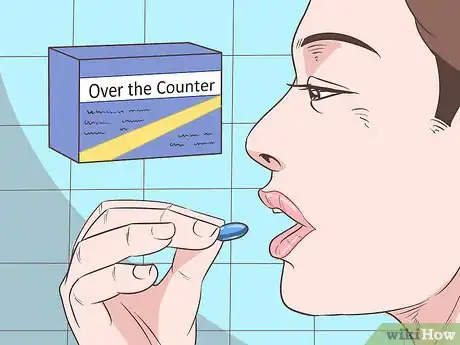This article was medically reviewed by Janice Litza, MD. Dr. Litza is a board certified Family Medicine Physician in Wisconsin. She is a practicing Physician and taught as a Clinical Professor for 13 years, after receiving her MD from the University of Wisconsin-Madison School of Medicine and Public Health in 1998.
There are 16 references cited in this article, which can be found at the bottom of the page.
wikiHow marks an article as reader-approved once it receives enough positive feedback. This article has 20 testimonials from our readers, earning it our reader-approved status.
This article has been viewed 314,996 times.
Experts note that while they have different causes, viral and bacterial upper respiratory infections have very similar symptoms.[1] Testing or having a clinical evaluation is the only way to know the cause for sure, but this can be costly and time consuming. Studies show that some subtle differences, like the length of your infection and the color of your mucus, can help alert you to whether you have a viral or bacterial infection.[2] Be sure to stay home and care for yourself if you're stick to give body time to rest and recover.
Steps
Observing Your Symptoms
-
1Track the length of your illness. In general, viral infections are milder than bacterial infections, but they tend to last longer. You will feel very sick for 1 to 3 days and then you will start to feel better, but some of your symptoms may linger. Symptoms that linger for a week or more may be a virus.[3]
- It's important to stay vigilant and talk to your doctor about antibiotics if symptoms last for a while.
- Viruses can morph into things like sinus infections or increase the risk of middle ear infections, which may result in you developing a bacterial infection as well.
-
2Pay attention to the color of your mucus. When you blow your nose or cough up mucus, pay attention to the color. While it may feel a little gross, color can be an indicator of whether you have a viral or bacterial infection.
- Thin and clear mucus is more likely to be a viral infection. Dark, greenish mucus is more likely to be a bacterial infection.
- However, mucus color is not a 100% accurate indicator of whether you have a viral or bacterial infection. Make sure to weigh in other factors.[4]
Advertisement -
3Observe your throat. A sore throat is common for both viral and bacterial infections. Checking for a sore throat is the most common test that will be performed in your doctor’s office to determine if you need antibiotics right away. Certain types of sore throats can indicate a bacterial infection.
- For example, white spots are generally caused by bacteria. A sore throat without other symptoms, such as a runny nose or sneezing, may be a bacterial infection such as strep throat.[5]
-
4Evaluate your fever. Fevers can be present in both viral and bacterial infections. However, fevers differ slightly with different types of infections. In bacterial infections, fevers tend to be higher. With a bacterial infection, fevers get worse after a few days while they tend to improve a few days in with a viral infection.[6]
- The normal human body temperature runs between 97.8° F (36.5°C) and 99°F (37.2°C).[7]
Evaluating Risk Factors
-
1Reflect on your likelihood of having the flu. The flu is caused by a viral infection.[8] If the flu is going around your office or place of work, remember it's highly contagious. If you've interacted with people with the flu recently, there is a good chance your symptoms are caused by the flu.[9]
- Keep in mind that there are treatment options for the flu if you are diagnosed and your symptoms started within two days of being diagnosed. Make sure to contact your doctor's office about your symptoms during flu season.[10]
-
2Think about age. Younger children are more prone to certain viral infections. Upper respiratory infections specifically are more common in younger children. If your child is displaying symptoms like a sore throat, sneezing, and coughing, they may have an upper respiratory infection.[11]
- If you believe your child has an upper respiratory infection, take them to see a doctor.
-
3Recall recent sinus infections. Sometimes, bacteria can start as a viral infection and morph into a bacterial one. If you recently had some kind of viral infection, such as a sinus infection, you may have developed a secondary bacterial infection. If you have had two illnesses close to one another, you may be more likely to have a bacterial infection.[12]
- In some cases, other viral infections could lead to a bacterial infection. Any illness that lingers for more than a couple of weeks should be evaluated by a doctor.
Seeking Medical Care
-
1See a doctor right away if you have certain symptoms. Most viral infections can be managed at home with self care. However, under certain conditions you should see a doctor right away. It's especially important these symptoms are addressed in children. See a doctor if you notice any of the following symptoms:[13]
- Urinating less than three times in 24 hours
- Difficulty breathing
- No improvement over three to five days
- Worsening of symptoms, or severe symptoms
- If you or a member of your household has a compromised immune system, you should be seen sooner to prevent complications.
-
2Take antibiotics for a bacterial infection. Antibiotics are used to treat bacterial infections and will not do anything to stop a viral infection. Doctors may not always prescribe antibiotics, even for bacterial infections, but they may be necessary if your infection is serious.[14]
- The only way to know for sure if you have a viral or bacterial infection is to get evaluated and discuss options with your doctor. A doctor will collect mucus or do a throat swab and send the sample to a lab. Your doctor may want to test you for a bacterial infection if they believe you would benefit from antibiotics.[15]
-
3Try over-the-counter medications for pain. If a viral or bacterial infection is causing you a lot of pain, ask a pharmacist about what over-the-counter pain medications may help. Make sure you use medications according to package instructions and ask a pharmacist whether they will interfere with any existing medications.[16]
- If you are prescribed an antibiotic, ask your doctor about which over-the-counter pain medications are safe to use with your antibiotics.
-
4Stay up-to-date on your vaccinations. It is important to stay current with all recommended vaccines as they are meant to prevent serious complications from both viruses and bacteria. Get a flu vaccination to protect you from the virus that causes the flu. While the flu is a viral infection, viral infections can some time lead to a bacterial infection. A flu shot can reduce your risk of developing viral and bacterial infections.[17]
- A flu shot will not protect from all viruses or bacteria. While it reduces your risk, you may still get sick.
- Many people qualify for pneumonia vaccinations as well. Make sure to discuss this with your doctor. [18]
- Inform your doctor or your healthcare provider in the emergency department if you or your child has not had routine immunizations. You might have an uncommon virus, like whooping cough or the measles, and will need to take special precautions for yourself and others.
Expert Q&A
-
QuestionI have left over antibiotics from my last infection. Is it ok to take the leftover medication for my sore throat?
 Janice Litza, MDDr. Litza is a board certified Family Medicine Physician in Wisconsin. She is a practicing Physician and taught as a Clinical Professor for 13 years, after receiving her MD from the University of Wisconsin-Madison School of Medicine and Public Health in 1998.
Janice Litza, MDDr. Litza is a board certified Family Medicine Physician in Wisconsin. She is a practicing Physician and taught as a Clinical Professor for 13 years, after receiving her MD from the University of Wisconsin-Madison School of Medicine and Public Health in 1998.
Board Certified Family Medicine Physician No. Different antibiotics work for different types of infections and taking unnecessary antibiotics or not completing the full course is leading to more resistant (hard to treat) infections. See your doctor for evaluation before deciding to take any antibiotics.
No. Different antibiotics work for different types of infections and taking unnecessary antibiotics or not completing the full course is leading to more resistant (hard to treat) infections. See your doctor for evaluation before deciding to take any antibiotics.
References
- ↑ https://www.healthdirect.gov.au/bacterial-vs-viral-infection
- ↑ https://www.dukehealth.org/blog/it-bacterial-infection-or-virus
- ↑ https://health.clevelandclinic.org/killer-sinus-infection-how-to-tell-if-yours-is-viral-or-bacterial/
- ↑ https://www.health.harvard.edu/blog/dont-judge-your-mucus-by-its-color-201602089129
- ↑ https://www.cdc.gov/groupastrep/diseases-public/strep-throat.html
- ↑ https://www.dukehealth.org/blog/it-bacterial-infection-or-virus
- ↑ https://medlineplus.gov/ency/article/001982.htm
- ↑ https://www.cdc.gov/flu/about/keyfacts.htm
- ↑ https://www.cdc.gov/flu/about/disease/spread.htm
- ↑ https://www.cdc.gov/flu/about/season/flu-season.htm
- ↑ https://my.clevelandclinic.org/health/articles/4022-upper-respiratory-infection
- ↑ https://www.cdc.gov/antibiotic-use/sinus-infection.html
- ↑ https://www.dukehealth.org/blog/it-bacterial-infection-or-virus
- ↑ https://medlineplus.gov/bacterialinfections.html
- ↑ https://www.ncbi.nlm.nih.gov/books/NBK8142/
- ↑ https://health.clevelandclinic.org/killer-sinus-infection-how-to-tell-if-yours-is-viral-or-bacterial/
- ↑ https://www.cdc.gov/flu/prevent/keyfacts.htm
- ↑ https://www.cdc.gov/vaccines/vpd/pneumo/public/index.html
- ↑ https://www.cdc.gov/flu/prevent/vaccine-benefits.htm
About This Article
You can tell a viral infection from a bacterial one by watching for symptoms like green or yellow mucus when you blow your nose, which usually indicates a bacterial infection. Additionally, you should check for white spots in the back of your mouth and throat, which can mean you have a bacterial infection like strep. Alternatively, if you have cold symptoms, but your mucus is clear, you may have a viral infection. Regardless of your symptoms, if your illness doesn’t start to improve after 3-5 days, make sure to visit your doctor for treatment. To learn how to tell if you have the Flu, read more from our Physician co-author.










































































Medical Disclaimer
The content of this article is not intended to be a substitute for professional medical advice, examination, diagnosis, or treatment. You should always contact your doctor or other qualified healthcare professional before starting, changing, or stopping any kind of health treatment.
Read More...